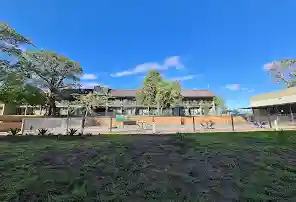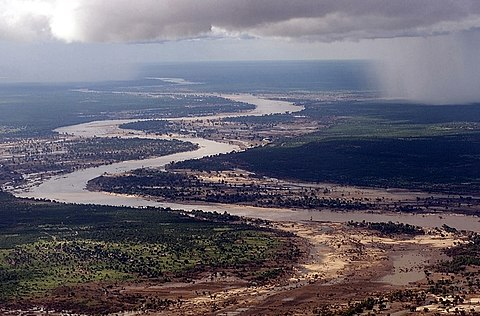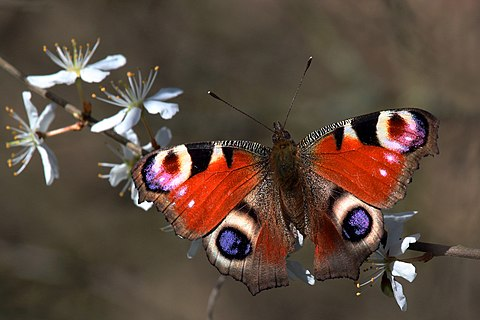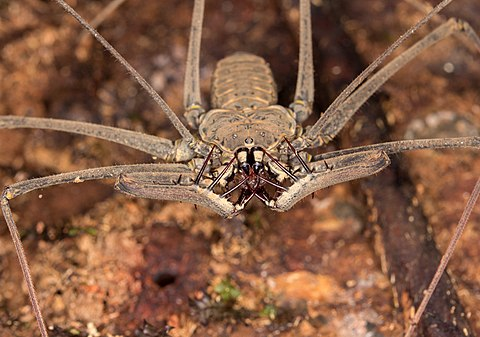Kruger National Park is a South African National Park and one of the largest game reserves in Africa. It covers an area of 19,623 km2 in the provinces of Limpopo and Mpumalanga in northeastern South Africa, and extends 360 km from north to south and 65 km from east to west. The administrative headquarters are in Skukuza. Areas of the park were first protected by the government of the South African Republic in 1898, and it became South Africa's first national park in 1926.
To the west and south of the Kruger National Park are the two South African provinces of Limpopo and Mpumalanga, respectively. To the north is Zimbabwe, and to the east is Mozambique. It is now part of the Great Limpopo Transfrontier Park, a peace park that links Kruger National Park with the Gonarezhou National Park in Zimbabwe, and with the Limpopo National Park in Mozambique.
The park is part of the Kruger to Canyons Biosphere, an area designated by the United Nations Educational, Scientific and Cultural Organization (UNESCO) as an International Man and Biosphere Reserve. The park has nine main gates allowing entrance to the different camps.
History
Pre-reserve (prior to 1898)
Over 420 recorded archaeological sites in Kruger Park attest to its occupation before modern times. Most sites however had relatively short occupation periods, as the presence of predators and the tsetse fly limited cattle husbandry. At Masorini hill, the H9 route, iron smelting was practiced up to the Mfecane era. The reconstructed Thulamela on a hilltop south of the Levuvhu River was occupied from the 13th to 16th centuries, and had links with traders from the African east coast.
 |
| Levuvhu River |
Before the Second Anglo-Boer War, the area now covered by the park was a remote section of the eastern South African Republic's last wild frontier. Paul Kruger, President of the South African Republic at the time, proclaimed the area, which was inhabited by the Tsonga people, a sanctuary for the protection of its wildlife. James Stevenson Hamilton noted many kraals along the Sabi River and also further north beyond the Letaba River although the north was sparsely populated compared to the south.
Many of the local natives were employed by railway companies for construction of rail connections, notably that between Pretoria (now in South Africa) and Lorenço Marques (now Maputo, Mozambique) during the end of the 19th century. Abel Chapman, one of the hunters who noted that the area was over-hunted by the end of the 19th century, brought this fact to wider attention.
 |
| Sabi River |
Sabi Game Reserve (1898 - 1926)
In 1895, Jakob Louis van Wyk introduced in the Volksraad of the old South African Republic a motion to create the game reserve. The area proposed extended from the Crocodile River to the Sabi River in the north. That motion, introduced together with another Volksraad member by the name of R. K. Loveday, and accepted for discussion in September 1895 by a majority of one vote, resulted in the proclamation by Paul Kruger, on 26 March 1898, of a "Government Wildlife Park." This park would later be known as the Sabi Game Reserve. The park was initially created to control hunting, and to protect the diminished number of animals in the park.
 |
| Crocodile River |
James Stevenson-Hamilton became the first warden of the reserve in 1902. The reserve was located in the southern one-third of the modern park. Singwitsi Reserve, named after the Shingwedzi River and now in northern Kruger National Park, was proclaimed in 1903. During the following decades all the native tribes were removed from the reserve and during the 1960s the last were removed at Makuleke in the Pafuri triangle. In 1926, Sabie Game Reserve, the adjacent Shingwedzi Game Reserve, and farms were combined to create Kruger National Park.
 |
| Shingwedzi River |
During 1923, the first large groups of tourists started visiting the Sabie Game Reserve, but only as part of the South African Railways' popular "Round in Nine" tours. The tourist trains used the Selati railway line between Komatipoort on the Mozambican border and Tzaneen in Limpopo Province. The tour included an overnight stop at Sabie Bridge (now Skukuza) and a short walk, escorted by armed rangers, into the bush. It soon became a highlight of the tour and it gave valuable support for the campaign to proclaim the Sabie Game Reserve as a national park.
 |
| Tzaneen |
Kruger National Park (1926 - 1946)
After the proclamation of the Kruger National Park in 1918, the first three tourist cars entered the park in 1927, jumping to 180 cars in 1928 and 850 cars in 1929.
Warden James Stevenson-Hamilton retired on 30 April 1946, after 44 years as warden of the Kruger Park and its predecessor, the Sabi Sabi Game Reserve.
1946 - 1994
Stevenson-Hamilton was replaced as warden by Colonel J. A. B. Sandenbergh of the South African Air Force. During 1959, work commenced to completely fence the park's boundaries. Work started on the southern boundary along the Crocodile River and in 1960 the western and northern boundaries were fenced, followed by the eastern boundary with Mozambique. The purpose of the fence was to curb the spread of diseases, facilitate border patrolling and inhibit the movement of poachers.
 |
| Olifants River |
The Makuleke area in the northern part of the park was forcibly taken from the Makuleke people by the government in 1969 and about 1500 of them were relocated to land to the south so that their original tribal areas could be integrated into the greater Kruger National Park.
 |
| Luvuvhu and Limpopo rivers at Crookes Corner in Pafuri triangle |
1994 - present
In 1996 the Makuleke tribe submitted a land claim for 19,842 hectares (198.42 km2), namely the Pafuri or Makuleke region in the northernmost part of the park. The land was given back to the Makuleke people, however, they chose not to resettle on the land but to engage with the private sector to invest in tourism. This resulted in the building of several game lodges from which they earn royalties.
 |
| Makuleke - secret Kruger National Park |
In the late 1990s, the fences between the Kruger Park and Klaserie Game Reserve, Olifants Game Reserve and Balule Game Reserve were dropped and incorporated into the Greater Kruger Park with 400,000 hectares added to the Reserve. In 2002, Kruger National Park, Gonarezhou National Park in Zimbabwe, and Limpopo National Park in Mozambique were incorporated into a peace park, the Great Limpopo Transfrontier Park.
 |
| Gonarezhou National Park |
In 2009, SANParks envisaged a four-star hotel northeast of Malelane on the bank of the Crocodile River, as part of a survival strategy to make the park less dependent on state subsidies. Eventually Radisson Blu was mandated to operate a 104-room safari resort starting 2019, which promises a smaller ecological footprint than that of prior, existing camps. The three-star, 128-room Skukuza Safari Lodge, to be completed by late 2018, was necessitated by the adjacent Nombolo Mdhluli conference center, opened in 2011, which draws guests arriving by charter flights or in tour busses.
Former head of the park Salomon Joubert warned that these developments threaten the character, ethos and original objectives of the park, but minister of environmental affairs, Edna Molewa, deemed development of 0.3% of the park as acceptable. The park was temporarily closed due to the COVID-19 pandemic on 25 March 2020. It was reopened on 8 June 2020.
 |
| Skukuza Safari Lodge |
Location and geography
The park lies in the north-east of South Africa, in the eastern parts of Limpopo and Mpumalanga provinces. Phalaborwa, Limpopo is the only town in South Africa that borders the Kruger National Park. It is one of the largest national parks in the world, with an area of 19,485 km2. The park is approximately 360 km long, and has an average width of 65 km. At its widest point, the park is 90 km wide from east to west.
To the north and south of the park two rivers, the Limpopo and the Crocodile respectively, act as its natural boundaries. To the east the Lebombo Mountains separate it from Mozambique. Its western boundary runs parallel with this range, roughly 65 km distant. The park varies in altitude between 200 m in the east and 840 m in the south-west near Berg-en-Dal. The highest point in the park is here, a hill called Khandzalive. Several rivers run through the park from west to east, including the Sabie, Olifants, Crocodile, Letaba, Luvuvhu and Limpopo Rivers.
 |
| Limpopo River |
Climate
The climate of the Kruger National Park and lowveld is subtropical/tropical, specifically a hot semi-arid climate (Köppen BSh). Summer days are humid and hot. The rainy season is from September until May. The Kruger National Park website lists September and October as the driest periods, culminating in the beginning of the rainy season late in October. Because the park spans 360 kilometres or 220 miles from north to south, climate can vary throughout the park. Skukuza in the southern part of the park is about 2 to 3 °C cooler throughout the year than Pafuri in the north, with significantly more rainfall.
 |
| Skukuza |
Biodiversity
Vegetation
Plant life consists of four main areas, which correspond roughly to the four quadrants of the park. The main veld types are determined by the rainfall gradient (400 to 750 mm per annum) and geological substrates.
 |
| Mixed thorn and marula woodlands occur in the southwest on granite |
Shrub mopane veld
Shrub mopane covers almost the entire north-eastern part of the park.
Red bush-willow and mopane veld
This area lies in the western half of the park, north of the Olifants River. The two most prominent species here are the red bush-willow (Combretum apiculatum) and the mopane tree (Colophospermum mopane).
 |
| Combretum apiculatum |
Thorn trees and red bush-willow veld
This area lies between the western boundary and roughly the centre of the park south of the Olifants River. Combretums, such as the red bush-willow (Combretum apiculatum), and Acacia species predominate while there are a great number of marula trees (Sclerocarya caffra). The Acacias are dominant along the rivers and streams, the very dense Nwatimhiri bush along the Sabie River between Skukuza and Lower Sabie being a very good example.
 |
| Combretums |
Knob-thorn and marula veld
South of the Olifants River in the eastern half of the park, this area provides the most important grazing-land. Species such as red grass (Themeda triandra) and buffalo grass (Panicum maximum) predominate while the knob-thorn (Acacia nigrescens), leadwood (Combretum imberbe) and marula (Sclerocarya caffra) are the main tree species.
 |
| Themeda triandra |
Local vegetation communities
There are a number of smaller areas in the park which carry distinctive vegetation. The Pretoriuskop sourveld and Malelane mountain bushveld receive relatively high rainfall. Here sickle bush and silver cluster-leaf (Terminalia sericea) are prominent. The sandveld communities northeast of Punda Maria are equally distinctive, with a wide variety of unique plant species. The bush-clad hills along the Levuvhu River also shelter an interesting floral diversity and some near-endemic species.
 |
| Terminalia sericea |
Mammals
All the big five game animals are found at Kruger National Park, which has more species of large mammals than any other African game reserve (at 147 species). There are webcams set up to observe the wildlife.
 |
| Mammals |
The park stopped culling elephants in 1994 and tried translocating them, but by 2004 the population had increased to 11,670 elephants, by 2006 to approximately 13,500, by 2009 to 11,672, and by 2012 to 16,900.
The park's habitats may only be able to sustain about 8,000 elephants, though this is not entirely clear. Elephants do change plant growth and density in the park, and some species, such as wildebeests, clearly benefit from an increase in grasslands.
The park started an attempt at using contraception in 1995, but has stopped that due to problems with delivering the contraceptives and upsetting the herd. The park has taken a firm stance against poaching of all animals especially the rhinoceros.
Kruger supports packs of the endangered African wild dog, of which there are thought to be only about 400 in the whole of South Africa.
Birds
A fairly uniform aggregate of bird species is present from the southern to central areas of the park, but a decline in diversity is noticeable in the mopane-dominated flats northwards of the Olifants. Most species breed in summer, when rains sustain most vegetable and animal food, but the larger birds of prey conversely breed during the dry winter, when their prey is most exposed. Out of the 517 species of birds found at Kruger, 253 are residents, 117 non-breeding migrants, and 147 nomads.
 |
| Birds of prey |
Constituting the southern lowveld, the park's avifaunal affinities are mainly with the tropical north. Some representatives of this group are the African openbill, hooded vulture, Dickinson's kestrel, white-crowned lapwing, brown-necked parrot, Senegal coucal, broad-billed roller, trumpeter hornbill, Böhm's spinetail, tropical boubou, Meves's starling and scarlet-chested sunbird.
 |
| Broad-billed roller |
Some 30 waterbird and wader species are dependent on the rivers or associated dams, including the African finfoot, white-backed night heron, white-crowned lapwing and water thick-knee.
 |
| African finfoot |
Other species are limited to riparian thicket or forest, including African goshawk, crested guineafowl, Natal spurfowl, Narina trogon, Pel's fishing owl, bearded scrub robin, terrestrial brownbul and black-throated wattle-eye. This habitat is often reduced by drought or floods or the understorey is opened up by elephant.
 |
| Crested guineafowl |
Some of the larger birds require large territories or are sensitive to habitat degradation. Six of these birds, which are by and large restricted to Kruger and other extensive conservation areas, have been assigned to a fanciful grouping called the "Big Six Birds". They are the lappet-faced vulture, martial eagle, saddle-billed stork, kori bustard, ground hornbill and the reclusive Pel's fishing owl, which is localized and seldom seen.
 |
| Martial eagle |
The 2011 aerial survey found 22 martial eagle nest sites, the 2015 survey an additional 17, while the 2020 survey found 70 nest locations in all, though the activity of these has yet to be determined. There are 25 to 30 breeding pairs of saddle-billed stork in the park, besides a handful of non-breeding individuals. In 2012 178 family groups of ground hornbills roamed the park and 78 nests were known, of which 50% were active. A 2013 study estimated that 904 pairs of white-backed vulture, 78 pairs of lappet-faced vulture and 60 pairs of white-headed vulture breed in the park.
 |
| White-headed Vulture |
Other vertebrates
Kruger is inhabited by 126 species of reptile, including black mambas, African rock pythons, and 3,000 Nile crocodiles. As yet, knowledge of the densities and distributions of the reptiles, especially on smaller spatial scales, is limited by sampling bias and a strong dependence on the park's public infrastructure is evident. Thirty-three species of amphibians are found in the park, as well as 50 fish species. A Zambesi shark, Carcharhinus leucas, also known as the bull shark, was caught at the confluence of the Limpopo and Luvuvhu Rivers in July 1950. Zambezi sharks tolerate fresh water and can travel far up rivers like the Limpopo.
 |
| African rock pythons |
Invertebrates
The total number of Lepidoptera species in the park is unknown, but could be in the order of 7,000, many of which range widely in African savanna. The mopane moth in the northern half of the park is one of the best known, and communities outside the park have at times been given permits to harvest their caterpillars.
 |
| Lepidoptera |
The park has a high diversity of termites and 22 genera are known to occur, including the mound-building genera Macrotermes, Cubitermes, Amitermes, Odontotermes and Trinervitermes. A new species of woodlouse, Ctenorillo meyeri, has been discovered inside termite nests, east of Phalaborwa and near Mopani Rest Camp.
 |
| Trinervitermes |
It is the first instance of a termitophilous species from the family Armadillidae. Many species of mosquito occur in the park, including the Culex, Aedes and Anopheles genera which target mammals. A. arabiensis is the most prevalent of the 9 or more Anopheles species in the park, and their females transmit malaria.
 |
| Aedes |
As of 2018, 350 species of arachnids, excluding ticks and mites, are known from Kruger. These are mostly true spiders, including 7 species of baboon spider, but also 9 scorpion and 7 pseudoscorpion species, 18 solifugid species (sun and roman spiders), 2 species of harvestmen and 1 species of tailless whip scorpion.
 |
| Tailless whip scorpion |
 |
| Massingir Dam |










No comments:
Post a Comment